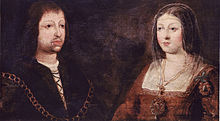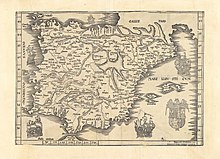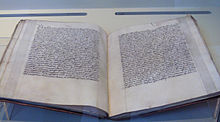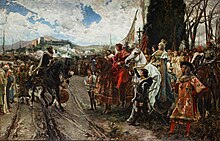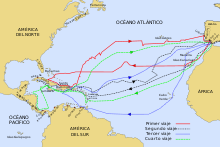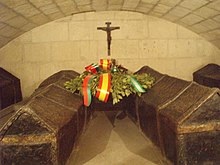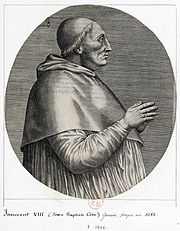Catholic kings
Catholic Monarchs was the name given to the married couple Isabella I of Castile and Ferdinand II of Aragon, sovereigns of the Crown of Castile (1474-1504) and of the Crown of Aragon (1479-1516).), whose dynastic union marked the beginning of the territorial formation of the kingdom of Spain. Likewise, Isabel and Fernando were the first monarchs of Castile and Aragon to be called "Kings of Spain".
Isabel acceded to the throne of Castile by proclaiming herself queen after the death of King Henry IV of Castile and thereby provoking the War of the Castilian Succession (1475-1479) against the supporters of Princess Juana, nicknamed "la Beltraneja", daughter of King Henry. In 1479 Fernando inherited the throne of Aragon when his father, King Juan II of Aragon, died. Isabella and Ferdinand reigned together until her death in 1504. Ferdinand was then left solely as King of Aragon, passing Castile to his daughter Juana, nicknamed "la Loca", and her husband Felipe of Austria, nicknamed "el Hermoso", Archduke of Austria, Duke of Burgundy and Count of Flanders. However, Fernando did not renounce control of Castile and, after Felipe died in 1506 and Juana was declared incapable, he managed to be named regent of the kingdom until his death in 1516.
Spanish historiography considers the reign of the Catholic Monarchs as the transition from the Middle Ages to the Modern Age. With their marriage bond, two crowns were provisionally united in the Trastámara dynasty: the Crown of Castile and the Crown of Aragon, originating the Hispanic Monarchy and, supported by the cities and the small nobility, established a strong monarchy against the desires of power of ecclesiastics and nobles. With the conquest of the Nasrid Kingdom of Granada, the Kingdom of Navarra, the Canary Islands, Melilla and other African places, they achieved the territorial union under a single crown of all the territories that today make up Spain —except for Ceuta and Olivenza, which then belonged to to Portugal—, which was characterized by being personal, since the sovereignties, norms and institutions of each kingdom and crown were maintained.
The kings established a common foreign policy marked by marriage liaisons with various royal families in Europe that resulted in Habsburg hegemony for centuries XVI and XVII.
On the other hand, the Conquest of America, starting in 1492, profoundly modified world history.
Marriage
The couple married in the Vivero palace in Valladolid on October 19, 1469, she was 18 years old and he was 17, spending their honeymoon in the castle of Fuensaldaña located in the current province of Valladolid. As they were second cousins, for their marriage to be recognized by the Church they needed a dispensation from the pope, which his supporters insistently requested from Paul II. As he refused to grant it, they used a false bull. For some, the author of the forgery was Alfonso Carrillo de Acuña, Archbishop of Toledo, while others maintain that it must have been written by the papal legate Antonio Veneris.
Domestic policy

Fight for the throne
The war of the Castilian succession was the war that lasted from 1475 to 1479 in which the daughter of the deceased King Henry IV of Castile, called Juana la Beltraneja or Juana de Trastámara, and Juana de Trastámara, and the monarch's stepsister, Isabel.
The war was an international conflict as Isabella was married to Ferdinand, heir to the Crown of Aragon, while Juana had married her uncle King Alfonso V of Portugal. For its part, France also intervened in the confrontation, supporting Portugal to prevent Aragon, her rival in Italy, from joining Castilla.
The battle of Toro fought on March 1, 1476 was, more than a military victory, a triumph for the marriage of Isabel and Fernando that was recognized in the Cortes de Castilla de Madrigal de las Altas Torres held between April and October 1476 and his daughter, the Infanta Isabel of Aragón sworn heiress to the crown of Castile.
However, the naval battle of Guinea in 1478, fought in the Atlantic Ocean, was decisive for the Portuguese, and where the Lusitanians prevailed over the Castilian fleet in the fight for access to the wealth of Guinea that the markets meant gold and slaves.
The war ended in 1479 with the signing of the Treaty of Alcáçovas, by which Isabel and Fernando were recognized as Kings of Castile, Juana losing all right to the throne and Portugal obtained hegemony in the Atlantic, with the exception of the islands Canary Islands.
Balance of power
On January 15, 1475, the princes Ferdinand II of Aragon and Isabel I of Castile agreed that they would have the same powers in the future government of their kingdoms, in a document called the Concord of Segovia. This system was in place for a long time, but as Queen Isabella grew older, she left more and more government powers in the hands of Ferdinand. By 1500, practically all power was in the hands of Ferdinand and his Aragonese advisers.
Political institutions of Castile and Aragon
Since the union of the Crown of Castile and the Crown of Aragon was only dynastic, the institutions of the kingdoms that formed them, plus the Kingdom of Navarre since its annexation, maintained their own institutions and laws.
Crown of Castile (Kingdoms of Castile and León)
In the kingdoms of Castilla and León, since the 13th century, with Alfonso X, a process of concentration of power in the Crown had begun, to the detriment of the nobility, with the creation of institutions that granted greater control over the territory and an increase in tax revenue. This transformation culminated in the reign of Isabel and Fernando and the creation of the Modern State.
The main government institution was the Royal Council, which was remodeled in the Cortes of Toledo in 1480, making it more structured and dividing it into parts. The kings delegated some decisions to him and soon a Council of Aragon and a Council of Orders were created. In addition, they began to give preference to lawyers over the nobility.
After the conquest of the Nasrid kingdom of Granada, the Audiencia de Granada was formed and there was an increase in the Castilian treasury due to taxes and manors from the distribution of the conquered territory.
To control banditry on the roads, and theft in general, the Holy Brotherhood (precursor of the current Civil Guard) was reinstated in 1476, which would be the first state police in Europe. Thanks to the taxes collected by this institution, the Crown significantly increased its income, with which it was able to govern more comfortably and thus dispense with the Cortes.
Crown of Aragon
The Crown of Aragon, on the other hand, barely changed. It had a very rigid system of government in each of the territories that comprised it (kingdom of Aragon, kingdom of Valencia, kingdom of Majorca, kingdom of Sardinia, kingdom of Sicily, principality of Catalonia, county of Roussillon and county of Cerdanya), with a series of privileges of the nobility that greatly limited the power of the king. The income was obtained by approval of the Cortes of each territory, which were practically controlled by the nobility and the clergy. With the association of the Crown to the kingdom of Castile, Fernando was able to count on Castilian tax revenues (which were much more abundant) so as not to convene the Cortes.
Greater power was given to the lieutenants of the area and the establishment of the electoral lottery, which consisted of taking a piece of paper from a bag with the proposed candidate. This innovation remained for another 30 years, being forgotten when the king died.
In the señorío municipalities, the corregidores were established, the authority at the municipal level, which had existed in Castile since 1393.
Religious politics

Along with the desire of the Catholic Monarchs to extend their rule to all the kingdoms of the Iberian Peninsula, their reign was characterized by religious unification around Catholicism.
Pope Innocent VIII granted the Catholic Monarchs the right of Patronage over Granada and the Canary Islands, which meant state control of religious affairs.
A bull of Pope Sixtus IV, in 1478, created the Inquisition in Castile to control the purity of the faith. Since in Aragon it existed since 1248, in this way the Spanish Inquisition was the only common institution for the two kingdoms. Fray Tomás de Torquemada's period as Inquisitor General was very hard.

In 1492 the Kings decreed the forced conversion to Christianity of the Jews in their kingdoms - calling them "marranos" - and the expulsion or execution of those who refused. Ten years later they also forced Muslims to convert to Christianity—referring to them as "Moorish"—or to leave Spain.
They also instituted a permanent embassy to the Holy See.
Economy and society
The economic base during the reign of the Catholic Monarchs was based on agriculture, sheep farming and the export of raw materials in Castile. To defend the wealth that wool represented, the Kings granted privileges to the Mesta with the Law for the Defense of Las Cañadas of 1489, threatened by farmers. Artisans were protected through internal trade.
Socially and economically they moderately favored the high nobility, as a reward for loyalty and who contributed men and economic resources to face the war conflicts, and who increased their economic power with the lordships of Granada. The Laws of Toro, of 1505, strengthened the institution of Mayorazgo.
In Catalonia, the problem of the remensa peasants was solved with the Guadalupe Arbitration Judgment of 1486, which suppressed misuse and forced the peasants to pay new taxes.
Foreign Policy
The successful expansionist foreign policy carried out by Fernando and Isabel was possible thanks to a series of factors:
- King Fernando's diplomatic initiative continued the traditional policy of the Crown of Aragon, with its interests placed in the Mediterranean Sea and in rivalry with France, which had never been an enemy of Castile.
- The diplomacy of Castile's kingdom was primarily aimed at the Atlantic Ocean and its overseas expansion towards the New World.
- The efficiency of the army of the Crown in charge of Gonzalo Fernández de Córdoba, known as the Grand captain. Fernandez de Córdoba reorganised the military troops on a new combat unit, the third, or the third, which resulted in the creation of the first modern army dependent on the crown, disposing of the monads of the nobles.
- The large contribution of economic resources from industry and the trade in wool and wheat.[chuckles]required]
- The marriage policy of kings.
Marriage Policy
The marriage policy of the Catholic Monarchs, consisting of marrying their children with those of other European monarchs, was the one commonly applied by the rulers of the late Middle Ages and early Modern Ages. In his case, they were mainly oriented towards the alliance with Portugal and the creation of a coalition against France.
The marriages of the children of the Catholic Monarchs were as follows:
- Isabel de Aragón, married to the Infante Alfonso de Portugal, and then with Manuel I of Portugal, uncle of her first husband. This marriage linked them to the Kingdom of Portugal.
- John of Aragon, married to Margaret of Austria, daughter of the Archduke Maximilian of Austria (now Maximilian I of Habsburg), of the Holy Roman German Empire and of Mary of Burgundy, Duke of Burgundy. John died prematurely in 1497. This marriage related them to the Holy Roman German Empire and the Duke of Burgundy.
- Juana, nicknamed the Loca, married Philip of Austria, nicknamed Philip the Beautiful, son of Emperor Maximilian I of Habsburg of Austria. This link again related to the Holy Roman German Empire.
- Mary of Aragon, married to Manuel I of Portugal, her brother-in-law, when her sister Isabel died.
- Catherine of Aragon, married the prince heir to the Crown of England, Arthur Tudor, who was the eldest son of Henry VII of England, and after the premature death of this, with his younger brother, the new King Henry VIII of England. These marriages involved them with the Kingdom of England.
The conquest of Granada
Once Isabel and Ferdinand had established themselves on the throne of Castile, they resumed the conquest of the Nasrid Kingdom of Granada, the last Muslim redoubt in the Iberian Peninsula, taking advantage of the fact that said kingdom was in a dynastic crisis between Sultan Abu- l-Hasan «Alí Mulei Hacén», his son Abu Abd-Alah, Mohámed XII «Boabdil» also called el Chico and Mohámed XIII «el Zagal», brother of the first and uncle of the second.
The war in Granada had several phases:
- 1484-1487: The western part of the kingdom of Granada is conquered by the Spanish-Argonese. Boabdil signed a treaty with the Kings, according to which the surrender of Granada would be exchanged for the Kings to give him a dominion in the eastern part of the kingdom.
- 1488-1490: The conquest of the east of the Nasrid kingdom began. The operating base was transferred to Murcia. During this stage "the Zagal" was surrendered.
- 1490-1492: Boabdil was required to deliver from Granada. When the Granada people heard of what was agreed, they opposed resistance, which was answered by the armies of the Kings. In the end Boabdil delivered Granada after a secret negotiations.
The victory of this war meant:
- The fall of the last Muslim kingdom of the Iberian peninsula in power of Christians, culminating in the Reconquest and increasing the prestige of the Catholic Kings in Christian Europe.
- The appearance of a structured and professional army, independent of the nobility, formed by the royal thirds.
- The contribution to the Crown of great economic resources.
- The prize and pacification of certain sectors of the nobility through the division of the Granada territories among them.
The conquest of the Canary Islands
In 1402, King Henry III of Castile granted Jean de Bethencourt the feudal privilege over the archipelago, beginning the conquest of the Canary Islands, until then inhabited by the Canarian aborigines, peoples with Berber roots who lived in a traditional way. independent. Subsequently, the Crown of Castile recovered for itself the right of conquest over the islands that the feudal lords had not been able to occupy: Gran Canaria, Tenerife and La Palma.
In 1478, within the framework of the Castilian succession war, the Castilians began the conquest of Gran Canaria. The sovereignty of the Canary archipelago was recognized to Castilla by the Treaty of Alcáçovas of 1479, which limited the Castilian and Portuguese territories as well as their respective areas of influence. After five years of war, the last indigenous resistance finally surrendered and accepted defeat in April 1483.
In 1491 the Catholic Monarchs continued their expansion and colonization company in the islands with the conquest of La Palma. This was definitively submitted the following year. The process of incorporating the Canary Islands into the Crown of Castile was completed with the end of the conquest of Tenerife in 1496, in the so-called Paz de Los Realejos.
The conquest of Navarre
At the beginning of the XVI century, the Kingdom of Navarre was divided into two factions: agramonteses and beamonteses, each one in favor of a different king. In this confrontation, the kings of Navarre signed a treaty with the king of France that put Spain in danger. Because the Kings of Navarre allied themselves with the King of France, who had been declared a schismatic and against whom the Lateran Council was to meet, a bull of excommunication was issued against them.
In 1512 Ferdinand the Catholic asked permission from Navarre —a natural ally of France (in an environment of continuous rivalry between Aragon and France)— for Spanish troops to pass through Navarre to attack France. The negative response from the King of Navarre was reason enough for Fernando the Catholic to order Fadrique Álvarez de Toledo y Enríquez, II Duke of Alba de Tormes, to occupy Navarre, thus sending help to his supporters —the Beamonteses— and, in Less than a year, the part of the Kingdom of Navarra located south of the Pyrenees was annexed to the Crown of Aragon. Some armed resistance only occurred in a few points in the south; Pamplona, the capital, fell in three days.
Expansion across the Mediterranean: Italy
Once the conquest of Granada was completed, King Charles VIII of France signed with King Ferdinand, in 1493, the treaty of Barcelona, through which the Crown of Aragon recovered Roussillon and Cerdanya in exchange for its neutral position before an imminent French attack on the kingdom of Naples, located in southern Italy.
The army of Charles VIII moved south of the Italian peninsula, dethroning Alfonso II, King of Naples and a relative of Ferdinand the Catholic. The situation of France in the Italian peninsula did not please the pope —the Valencian Alexander VI— since he endangered the Papal States, for which he asked the Catholic King for help. Fernando did not hesitate to intervene and, in a short time, the army of Gonzalo Fernández de Córdoba, the Great Captain, expelled the French, recovering the throne from him the Neapolitan king.
In 1500 the new King of France Louis XII signed the Treaty of Granada with Ferdinand the Catholic to jointly occupy the kingdom of Naples. Ferdinand agreed and the King of Naples, then Federico I, was dethroned. Both armies occupied the area, but disagreements began to arise and a guerrilla fight began. Despite the numerical inferiority of his army, the Great Captain defeated the French and expelled them from Italy. The Kingdom of Naples was conquered again and included in the Crown of Aragon.
During the last years of the reign of Ferdinand the Catholic, the intervention of the Crown of Aragon in Italian affairs resumed. Fernando participated in the Cambrai League of 1508, called by Pope Julius II against Venice. After this league began to produce friction between the Pontiff and France. For the help requested by the pope, Ferdinand surrounded Rome with his troops in the face of a possible French attack to remove the pope.
Expansion into North Africa
After the conquest of Granada, the Catholic Monarchs decided to start the conquest of North Africa, with the argument of the continuation of the Christian Reconquest by the former Mauritania Tingitana province of Roman Hispania, and with the strategic objectives of preventing the the kingdoms of North Africa undertook a reconquest of Granada and eliminate the sources of Barbary piracy in the area.
The conquest began with the capture of Melilla by Pedro de Estopiñán in 1497 and continued in 1505 with the capture of Mazalquivir. Subsequently, the Spanish troops occupied the Peñón de Vélez, Orán, Bugía, Algiers, Tunis, La Goleta and Tripoli; with outstanding military participation of Cardinal Cisneros, confessor to Queen Isabella and Archbishop of Toledo, probably the third most powerful person in Spain at the time. The conquest of North Africa was interrupted in 1510 due to the resumption of the wars in Italy and because it began to prove more profitable to direct efforts to colonize the Indies.
Expansion across America
In 1486, the sailor Christopher Columbus offered the Catholic Monarchs a project: to travel west to the Indies, on a new route across the Atlantic. The reports from the monarchs' advisors in this regard were not very favorable to Columbus, and for the crown the conquest of Granada was a priority issue at that time. After this, the Catholic Monarchs accepted his project. Through the Capitulations of Santa Fe, on April 17, 1492, they named Columbus admiral, viceroy and governor of the undiscovered territories and granted him a tenth of all the benefits obtained. The cost of the expedition was estimated at 2,000,000 maravedis, plus Columbus' salary. The popular idea that he was supported by "the jewels of Isabel la Católica" is false.
On August 3, 1492, Columbus set sail from Puerto de Palos. On October 12 they reached the island of Guanahaní, in the Bahamas, and from there they went to Cuba and Hispaniola, beginning the Discovery of America. The return of Martín Alonso Pinzón to Galicia and of Columbus to Portugal unleashed a diplomatic crisis between the King of Portugal and the Catholic Monarchs that concluded with the signing in 1494 of the Treaty of Tordesillas to redistribute the sphere of territorial influence of each country that had established in the Treaty of Alcáçovas. Meanwhile, the Kings sent a second, much larger expedition to the discovered lands, also led by Columbus. In the following years, the Castilian navigators explored the rest of the Antilles as well as the continental coast of the Caribbean Sea. However, they did not reach the Asian continent, as Columbus had initially promised. This, together with the fact that the colony founded in Hispaniola was plagued by famines and revolts, ended up leading the Kings in 1499 to relieve Columbus of his posts, appoint a new governor and grant discovery licenses to other businessmen.
In the Indies, annexed to the kingdom of Castile, the traditional administrative systems of the Castilian kingdom were established. The Casa de Contratación was established in Seville in 1503 to monopolize and control trade with America, the Canary Islands and Barbary, preventing any other port in Spain from doing so. The Audiencia of Santo Domingo was created in 1510 and, for the administration of the new territories, an antecedent of the Council of the Indies was created that would later be formally instituted by Carlos I in 1523, organizing it in the likeness of the Council of Castile.
The kings obtained the Patronage of the Indies from the pope, which allowed them to control the American Church. The encomiendas were also established to evangelize the Indians.
Succession
Regency of Ferdinand the Catholic (1508 to 1516)
Queen Isabella died on November 26, 1504, leaving Ferdinand a widower with no clear rights to the Castilian throne. Signed the Concord of Salamanca, in 1505, the government was joint between her daughter Juana, her husband Felipe and Fernando himself. But before disagreements between Felipe and Fernando and by the Concord of Villafáfila, of 1506, the latter withdrew from the power of Castile and returned to Aragon. This is how the marriage reigned in Castile. However, this situation did not last long, as Philip died in 1506.
After the death of her husband, Queen Juana was declared mentally incapacitated and Cardinal Cisneros was appointed regent, who together with the Cortes asked Fernando to return to govern Castile. Fernando returned and held his second regency in 1507, forming a duo with Cisneros and governing both until Carlos, Juana's son, reached the age of majority.
During the regency of Fernando and Cisneros, Navarre was incorporated into the kingdom of Castile and Fernando remarried to Germana de Foix, less than a year after the death of his previous wife, Isabel.
Fernando the Catholic died in 1516 in Madrigalejo, Cáceres, before Carlos I came to the Spanish throne. Thus, Cisneros, who died on the way to Asturias to welcome the new king, Carlos I of Spain, remained as the sole regent in Castile. At the same time, in Aragon the Archbishop of Zaragoza, Alonso de Aragón, remained as regent until the arrival of Carlos I of Spain.
Burial
The remains of the Catholic Monarchs rest in the Royal Chapel of Granada, a place chosen by them and created by Royal Decree dated September 13, 1504.
Symbols
Title of "Catholic Monarchs"
The tomb of Pope Innocent VIII (died 1492), located in Saint Peter's Basilica and made by the sculptor Antonio Pollaiuolo, has an inscription in Latin, in marble, where the following appears, along with other sentences:[citation required]
REGI HISPANIARUM CATHOLICI NOMINE TAX
The initiative to grant Ferdinand and Isabella the title of "Catholic Monarchs" came from the Spanish court and specifically from Enrique Enríquez, who was Ferdinand's uncle and also in-law of Pope Alexander VI (Rodrigo Borgia) (1431-1503), successor in the papacy of Innocent VIII. In the bull Inter caetera, dated May 4, 1493, one of the Alexandrian Bulls, Pope Alexander addressed the kings in the following terms:
Among all works pleasing to the Divine Magestad and desirable to our heart, this is certainly the main thing; that the Catholic Faith and the Christian Religion be exalted above all in our times (...). From where (...); recognizing you as true kings and Catholic princes, as we know that you were always, and show it your pre-clear facts, known already in almost all the orb, and that you not only desire it, but that you practice it with all diligence, reflection and diligence, without forgiving any work, no danger, no expense, until you pour out so much blood; and that to this you have spent all your days Whereas, having diligently considered all things and capitally the exaltation and spread of the Catholic faith as it corresponds to the Catholic Kings and Princes, you decided according to the custom of our parents (...)
In a letter dated May 1494, the nuncio Francisco Desprats advised the pope to accept Enrique Enríquez's request to give the kings the title of «Very Catholics» (molt catolichs in the Finally, the title of "Catholic Kings of Spain" was officially granted by Alexander VI in favor of Ferdinand and Isabella in the bull Si convenit, issued on December 19, 1496.
This bull was drafted after a debate in the College of Cardinals, held on December 2, 1496, with the direct advice of the three cardinals who enumerated the merits of the two kings so that they would be granted a title that no one had possessed: Oliverio Caraffa -from Naples-, Francisco Piccolomini -from Siena-, and Jorge de Costa -from Lisbon- and in which other possible titles were considered and ruled out.
The papacy based its granting of the title on six fundamental causes:
- The personal virtues which both Kings possessed manifested in the unification, pacification and strengthening of their kingdoms.
- The reconquest of Granada from the hands of Islam.
- The expulsion of the Jews in 1492.
- The liberation of the Pontifical States and the papal fiefdom of the kingdom of Naples invaded by King Charles VIII of France.
- The efforts made and the projects to bring war to the unfaithful in Africa.
The granting of the title generated protests from the French ambassador, who saw the new title as incompatible with that of Most Christian held by the King of France since 1464; and the ambassador of Portugal, who complained that the term "Spains" included his country, which had been part of Roman Hispania.
Pope Leo X, in the bull Pacificus et aeternum, of April 1, 1517, granted the same title of Catholic King to King Carlos, being incorporated into diplomatic and chancellery use.
The title was later inherited and retained by his successors, theoretically up to the current King Felipe VI of Spain. The current Spanish Constitution recognizes the use of titles "corresponding to the Crown" by the King of Spain, so according to some it could also be called Catholic King or His Catholic Majesty or Catholicus Rex[citation required]. However Felipe VI has never used this title.
Title of «Kings of Spain»
The prologue to the Diary of Christopher Columbus, preserved in a handwritten copy by Fray Bartolomé de las Casas, addressed the monarchs Ferdinand and Isabella as "King and Queen of Spain":
For the most holy and very high and very excellent and very powerful Princes, King and Queen of the Spains and of the islands of the sea, Our Lords, this present year of 1492, after Your Highnesses see the end of the war of the Moors...
The papal bull Si convenit, of 1496, also named the kings, “king and queen of Spain”.
Heraldry
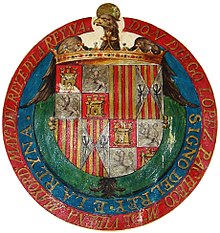
Fernando had a yoke as his personal emblem, with a loose rope and the heraldic nickname “tanto monta”, in reference to the Gordian knot that was on a rope tied to a yoke. According to legend, whoever undid the Gordian knot could conquer the East. Alexander the Great cut the knot with his sword and said: "Both mount to cut and untie", a phrase that Fernando took as a motto, abbreviated in the heraldic nickname "both mount".
Isabel took the bundle of arrows as her emblem, which was represented sometimes tied, sometimes loose, or with parallel arrows in a variable number. Each of these emblems honored the consort with his initial: "F" for Fernando on Isabel's arrows, and "Y" for the queen —Ysabel, with the spelling of the time— on the Fernandino yoke.
As for the support of the eagle of Saint John, it was first used by Elizabeth while she was still a princess in 1473. On a shield from that year, the eagle that symbolizes John the Evangelist appears haloed and not crowned, undoubtedly due to that she had not yet been crowned Queen of Castile, an event that would take place in Segovia at the end of 1474. Later she was incorporated into the combined arms of both.
Filmography
Cinema
| Year | Movie | Director |
|---|---|---|
| 1945 | The carabela of illusion | Benito Perojo |
| 1948 | Madness of love | Juan de Orduña |
| 1951 | Alba de América | Juan de Orduña |
| 1949 | Christophe Colomb | David MacDonald |
| 1976 | Black sword | Francisco Rovira Beleta |
| 1982 | Christopher Columbus, of course... discoverer | Mariano Ozores |
| 1983 | Juana's crazy... | José Ramón Larraz |
| 1992 | 1492: The Conquest of Paradise | Ridley Scott |
| 1992 | Christopher Columbus: the discovery | John Glen |
| 2000 | Isabel of Castille: The Royal Diaries | William Freud |
| 2001 | Juana la Loca | Vicente Aranda |
| 2006 | Queen Elizabeth in person | Rafael Gordon |
| 2016 | The starting crown | Jordi Frades |
TV Series
| Year | Series | Producer |
|---|---|---|
| 2012-2014 | Isabel | Diagonal TV for RTVE |
| 2017 | Conquerors: Adventum | Movistar+ |
| 2015 | The Ministry of Time | 1 |
Contenido relacionado
Miguel Angel
Jose Marti
Kimigayo
